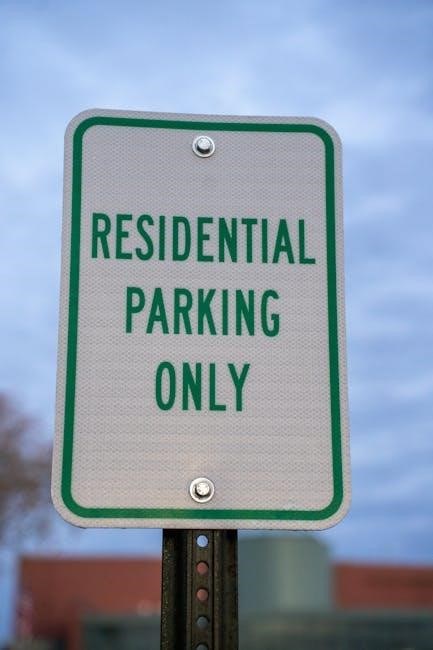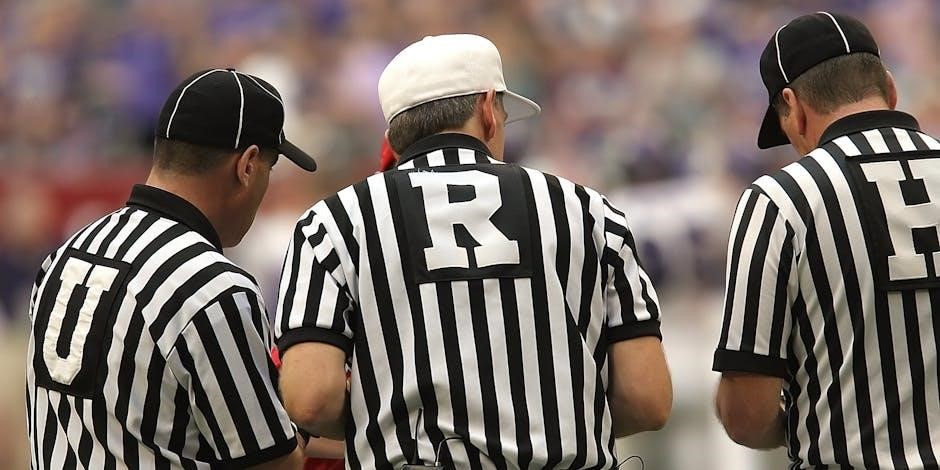Basketball rules and regulations are essential for fair play, outlining court dimensions, scoring, fouls, and gameplay. FIBA governs international rules, ensuring consistency worldwide in competitions and leagues.
Overview of Basketball as a Sport
Basketball is a dynamic and popular team sport played globally, invented in 1891 by James Naismith. It involves two teams of five players each, aiming to score by shooting a ball into the opponent’s hoop. The game is played on a rectangular court with a hoop at each end, requiring skill, strategy, and physical fitness. Its fast-paced nature and emphasis on teamwork make it a fan favorite. Basketball’s simplicity in equipment—a ball and a hoop—has contributed to its worldwide adoption. Professional leagues like the NBA have further elevated its global appeal, making it one of the most watched and played sports internationally.
Importance of Rules in Basketball
Basketball rules are essential for ensuring fair play and safety. They provide a clear framework for players, officials, and spectators to understand the game’s objectives and boundaries. Without rules, the game would lack structure, leading to chaos and confusion. Rules ensure that competitions are conducted fairly, preventing disputes and promoting sportsmanship. They also allow for consistent enforcement across all levels of play, from amateur to professional leagues. Additionally, rules evolve to improve the game, such as changes to shot clocks or foul limits. Overall, rules are vital for maintaining the integrity and enjoyment of basketball.
FIBA and Its Role in Basketball Governance
FIBA, the International Basketball Federation, serves as the governing body for basketball worldwide. It is responsible for creating and enforcing the official rules and regulations of the sport. FIBA oversees international competitions, including the FIBA Basketball World Cup and the Olympic basketball tournaments. The organization works to unify the rules of basketball across different countries and leagues, ensuring consistency and fair play. By promoting the sport globally, FIBA contributes to the growth and development of basketball at all levels. Additionally, FIBA regularly updates rules to enhance gameplay and player safety, ensuring the sport remains dynamic and inclusive. Its role is crucial in maintaining the integrity and universality of the game.

Key Components of Basketball Rules
Basketball rules define gameplay, ensuring fair and fast-paced competition. They cover court dimensions, timing, scoring, fouls, violations, substitutions, and team composition, forming the game’s structure.
The Basketball Court Dimensions
A basketball court must adhere to specific dimensions to ensure fair play. Professional courts, like those in the NBA, are 29 meters long and 16 meters wide, while FIBA-standard courts are slightly smaller at 28 meters by 15 meters. The free throw line is 4.6 meters from the hoop in FIBA rules and 4.5 meters in NBA rules. The three-point line varies, with FIBA at 6.75 meters and NBA at 7.24 meters. The hoop itself is 3.05 meters above the floor. Consistent court dimensions ensure uniformity and fairness in gameplay, as outlined in the official basketball rules and regulations PDF.

Game Timing Rules
Basketball games are divided into four quarters, each lasting 12 minutes in professional play and 10 minutes in college and international games. Overtime periods are five minutes each if the score is tied at the end of the fourth quarter. The shot clock, which varies by league, ensures teams attempt a shot within 24 seconds in professional leagues. Teams have a limited number of timeouts. Halftime and quarter breaks provide strategic stops. These timing rules ensure the game’s pace and fairness, as outlined in the official basketball rules and regulations PDF.
Scoring Systems in Basketball
Basketball scoring is based on field goals and free throws. A field goal, made by shooting the ball into the opponent’s hoop, is worth two points if made within the three-point line and three points if made beyond it. Free throws, awarded for fouls, are worth one point each. Additional points can be scored through tip-ins or dunks. The team with the highest score at the end of four quarters wins. Detailed rules on scoring, including conditions for made shots and fouls, are outlined in the official basketball rules and regulations PDF, ensuring clarity for players and officials alike.

Fouls and Violations
Fouls and violations are crucial aspects of basketball rules, ensuring fair play and player safety. Personal fouls, such as holding or pushing, result in free throws for the opposing team. Technical fouls are called for unsportsmanlike behavior, like arguing with officials, and often lead to free throws or possession. Flagrant fouls involve excessive contact and can result in ejections. Violations, such as traveling or double dribbling, stop play and award the ball to the opposing team. Understanding fouls and violations is essential for players, coaches, and referees to maintain the integrity of the game, as detailed in the official basketball rules and regulations PDF.
Player Substitutions and Team Composition
Basketball teams consist of five players on the court and up to seven substitutes. Substitutions occur during stoppages in play, such as timeouts or fouls, and must be requested through the scorer’s table. Teams can make unlimited substitutions, but players must enter and exit the court at the designated substitution area. Each team must have at least five players to start the game. Coaches are responsible for managing substitutions strategically to maintain player performance and team dynamics. Proper substitution protocols ensure smooth gameplay and adhere to the rules outlined in the official basketball regulations document.

Equipment Specifications
Basketball Equipment
The official basketball must meet FIBA standards, with size 7 for men and size 6 for women. The hoop measures 3.05 meters high, with a 45cm rim. Courts require appropriate markings, including the free-throw line and three-point line, ensuring fair play and safety.
Basketball Size and Weight
The official basketball must meet specific size and weight requirements. For men, the ball is Size 7, weighing 567-650 grams with a circumference of 74-77 cm. Women use Size 6, weighing 510-567 grams with a circumference of 72-73 cm. The ball must be made of leather or synthetic material, providing consistent bounce and grip. These standards ensure fair play and consistency across all levels of competition. Proper ball size and weight are essential for player safety and performance, adhering to FIBA and NBA regulations. The ball’s color is typically orange with black panels for visibility. These specifications are strictly enforced in official games.
Hoop and Rim Dimensions
The basketball hoop consists of a rim with a diameter of 18 inches (45.7 cm) and a height of 10 feet (3.05 meters) from the floor. The rim is supported by a backboard, which measures 6 feet (1.83 meters) wide and 3.5 feet (1.07 meters) tall. The backboard is typically made of glass or a high-quality synthetic material. The rim must be flexible to absorb impact, such as with breakaway rims, to prevent injury during dunks. These dimensions ensure consistency across all levels of play, from amateur to professional leagues. The precise measurements are crucial for maintaining fair and standardized gameplay worldwide.
Court Markings and Equipment
Basketball courts feature specific markings essential for gameplay, including the center circle, free throw line, three-point line, and the key. The center circle has a diameter of 12 feet, while the free throw line is 15 feet from the hoop. The three-point line varies slightly by league, measuring 22 feet in professional play and 23.75 feet internationally. The key, or free throw lane, is 16 feet wide in NBA and 17 feet in FIBA games. Sidelines and baselines are 94 feet long in professional leagues. Additional equipment includes scoreboards, shot clocks, and backboards made of glass or synthetic materials to ensure safety and visibility.

Rules Governing Gameplay
Gameplay rules ensure fair play, outlining ball movement, scoring, fouls, and time management. They define legal plays, violations, and penalties, promoting competitive and safe basketball.
Ball Movement and Dribbling Rules
Ball movement and dribbling are essential components of basketball. Players must advance the ball by dribbling or passing, with no carrying or kicking. Dribbling requires the ball to bounce continuously, and double dribbling is prohibited. Teams must move the ball forward within five seconds, and players cannot travel or take more than two steps without dribbling. Violations like over-and-back or three seconds in the paint also apply. These rules ensure fluid gameplay, fair competition, and strategic team play. Proper ball movement and dribbling techniques are critical for offensive success and maintaining possession. Adherence to these rules is enforced by referees.
Shot Clock and Time Management
The shot clock is a critical rule in basketball, ensuring offensive teams score or shoot within a set time. In FIBA and NBA, the shot clock is 24 seconds, while NCAA uses 30 seconds. Teams must attempt a shot that reaches the rim before the clock expires. The shot clock resets on rebounds, fouls, or when the ball goes out of bounds. Proper time management is vital, as violations like shot clock expiration result in turnovers. This rule promotes offensive efficiency and fast-paced gameplay, preventing stagnation and encouraging strategic play. It is a cornerstone of modern basketball, enhancing both competition and spectator experience.
Defensive and Offensive Strategies
Defensive and offensive strategies are integral to basketball, shaping team performance and game outcomes. Defenses often employ tactics like man-to-man, zone, or press to disrupt opponents, while offenses use strategies such as pick-and-rolls, screens, and fast breaks to create scoring opportunities. Teams must balance individual skill with collective coordination, adapting strategies based on player strengths and opponents’ weaknesses. Effective communication and timing are crucial for executing plays and defending against them. These strategies require practice, teamwork, and in-game adjustments, making basketball a dynamic and tactical sport. Understanding these elements is essential for players and coaches to maximize their competitive edge and achieve success on the court.

Official Basketball Rules Documents
Official basketball rules are documented in FIBA’s Official Basketball Rules (OBR), NBA rulebooks, and NCAA guidelines, ensuring standardized gameplay across professional and amateur levels globally.
FIBA Official Basketball Rules (OBR)
The FIBA Official Basketball Rules (OBR) serve as the universal governing document for basketball, outlining gameplay standards worldwide. Published annually, the OBR ensures consistency across all levels, from amateur to professional leagues. It covers court dimensions, scoring, fouls, and player conduct, providing clarity for referees, players, and coaches. The OBR is widely recognized and adopted by international competitions, including the Olympics and FIBA World Cups. Regular updates reflect evolving gameplay and technological advancements. The OBR is available as a downloadable PDF, making it accessible for anyone seeking detailed rules and regulations. Its adherence ensures fair and standardized basketball globally.
NBA Rule Differences
The NBA has distinct rule variations compared to FIBA, tailored to enhance its fast-paced, high-scoring style. Key differences include a longer game duration (48 minutes vs. FIBA’s 40) and a shorter shot clock (24 seconds in the NBA vs. 30 in FIBA after an offensive rebound). The NBA permits defensive three-second violations to prevent defenders from lingering in the paint. Additionally, the NBA allows zone defenses, whereas FIBA emphasizes man-to-man. The “take” foul, legal in the NBA for breaking up fast breaks, is prohibited under FIBA rules. These differences create a unique basketball experience, blending athleticism with strategic play.

NCAA and WNBA Rule Variations
The NCAA and WNBA have rule variations that adapt basketball to their specific competitive levels. In the NCAA, games are divided into two 20-minute halves, and the shot clock is 30 seconds for men (25 seconds for women). The WNBA, aligning closer to the NBA, uses a 24-second shot clock and features a shorter 3-point line. Both leagues enforce stricter rules on physicality compared to professional leagues, emphasizing player safety. The WNBA also allows for slightly more lenient contact, mirroring the NBA’s style, while the NCAA prioritizes foul calls to maintain a balanced game flow and protect student-athletes.

Recent Changes in Basketball Rules
Recent rule updates focus on enhancing player safety, improving game flow, and maintaining competitive balance. These changes reflect the evolving nature of basketball governance and play.
2024 Rule Updates by FIBA
FIBA introduced several rule changes for 2024 to enhance gameplay and player safety. Key updates include adjustments to foul limits, shot clock resets, and defensive strategies. These changes aim to improve game flow and reduce stoppages. Additionally, rules regarding ball movement and offensive possessions were refined to encourage faster-paced and more dynamic play. FIBA also emphasized stricter enforcement of unsportsmanlike fouls to protect players. These updates align with global trends in basketball, ensuring consistency across international competitions. The new rules are outlined in the latest official basketball rules and regulations PDF, available for download on FIBA’s website.
Impact of Rule Changes on Gameplay
The 2024 rule changes by FIBA have significantly influenced basketball gameplay. Faster-paced matches have emerged due to shot clock adjustments and reduced stoppages. Offensive teams now benefit from clearer rules on ball movement, encouraging dynamic playmaking. Defensive strategies have evolved, with coaches adapting to new restrictions on help-side defense. Player safety has improved with stricter enforcement of unsportsmanlike fouls. Fans are experiencing more thrilling games, while players face new challenges in adapting to the updated regulations. These changes reflect FIBA’s commitment to modernizing basketball while maintaining its core competitive spirit. The impact is evident in international competitions and grassroots levels alike.

Accessing Official Basketball Rules
Official basketball rules are available through FIBA’s website, offering downloadable PDFs. These resources provide detailed guidelines for players, coaches, and referees to ensure accurate rule interpretations.
Downloading the Official PDF
The official basketball rules and regulations can be downloaded as a PDF from FIBA’s website. This document is freely accessible and contains detailed guidelines, diagrams, and interpretations. To download, visit the FIBA official website, navigate to the “Rules” section, and select the most recent edition of the Official Basketball Rules. The PDF is compatible with all devices and provides a comprehensive overview of game rules, court dimensions, and player conduct. Regular updates ensure the rules remain current, making it essential for referees, coaches, and players to reference the latest version for accurate gameplay.
Online Resources for Rule Interpretations
Beyond the official PDF, numerous online resources provide interpretations and clarifications of basketball rules. FIBA’s official website offers detailed rulebooks, videos, and infographics to explain complex regulations. The NBA and NCAA also publish rule summaries tailored to their specific leagues. Additionally, platforms like YouTube feature video breakdowns of rule applications during games. Forums and blogs, such as those hosted by basketball coaching communities, offer in-depth discussions and practical examples. These resources are invaluable for referees, coaches, and players seeking to understand rule enforcement and interpretations in real-game scenarios.
Basketball rules ensure fair play, safety, and exciting competition. Understanding them enhances enjoyment for players and fans. Refer to official PDFs and online resources for detailed insights.
Basketball rules govern gameplay, ensuring fairness and structure. The court dimensions, game timing, and scoring systems are foundational. Fouls and violations regulate player conduct, while substitutions and team composition define participation. Equipment specifications ensure uniformity, from ball size to hoop dimensions. Rules on ball movement, dribbling, and shot clocks maintain pace and strategy. Defensive and offensive tactics are shaped by these guidelines. Understanding official rulebooks, like the FIBA OBR, NBA, NCAA, and WNBA variations, is essential. Recent rule updates refine gameplay, emphasizing safety and competitiveness. Accessing official PDFs and online resources provides clarity on interpretations, ensuring consistent application across all levels of play.
Future of Basketball Rule Development
The future of basketball rule development focuses on enhancing gameplay, safety, and fan engagement. Technology, such as AI-enabled refereeing tools, may streamline decision-making and improve accuracy. Rule changes could emphasize player safety, particularly regarding contact and injury prevention. There may be adjustments to shot clock timing or foul limits to increase scoring and pace. Virtual and augmented reality could integrate with rule updates to enhance spectator experiences. Environmental sustainability might influence equipment standards, promoting eco-friendly materials. Global rule harmonization will remain a priority, ensuring consistency across leagues. As basketball evolves, rule updates will aim to balance tradition with innovation, keeping the sport dynamic and inclusive for all levels of play.



